Aug 17, 2021 | news, US Mint
 According to Coin World, the Treasury Office of Inspector General (OIG) “may” investigate how the U.S. Mint has handled the sales of limited-edition numismatic collectibles. Coin World may have confirmed information provided to me on background.
According to Coin World, the Treasury Office of Inspector General (OIG) “may” investigate how the U.S. Mint has handled the sales of limited-edition numismatic collectibles. Coin World may have confirmed information provided to me on background.
Although the web-based ordering has sort-of worked, I reported on the systemic issues facing the U.S. Mint in moving forward. In summary, my investigation found:
- The alleged silver shortage was not a shortage of silver but a failure of the U.S. Mint to manage its supply chain properly.
- The U.S Mint’s insistence that Internet robots (BOTs) were the cause of their web-based issues was the symptom of a more significant problem that they have not learned from their past mistakes.
- The U.S. Mint’s management managing like they were afraid of repercussions because the lawyers said so. The way it sounded, the U.S. Mint management was not managing but taking instructions. If they cannot manage, should they be replaced by lawyers?
An investigation by the Treasury OIG is an excellent first step. But experience has shown that an OIG report does not guarantee that U.S. Mint will fix the problems. I have seen government managers and appointees say all of the right things and do little to nothing.
It might require an act of Congress to fix the U.S. Mint. If it requires an act of Congress, don’t hold your breath waiting for changes.
Aug 15, 2021 | Eagles, news, US Mint
Although this past week was the World’s Fair of Money, there was not much news surrounding the event. According to individual reports, people said that it was a good show even with the COVID precautions. It was similar to reports from The National, which was held in the Stephens Convention Center the week before.
The week’s biggest news was the U.S. Mint publishing the lot numbers used to label the boxes with the American Eagle bullion coins.
Until last year, the U.S. Mint has not identified where they strike the American Eagle bullion coins. Spokespeople emphasize that since their production is for the investment market, the mint location is not relevant. Of course, collectors view the market differently. Dealers and third-party grading services have tried to determine where the coins were struck based on shipping labels and other factors. Although they are reasonably sure, there are mistakes in their assumptions.
In 2020, the COVID-19 pandemic caused the West Point Mint to close temporarily. To keep up with production, the U.S. Mint struck 240,000 bullion coins in Philadelphia. The third-party grading services asked the U.S. Mint about the production of these coins. Rather than leave the industry guessing, the U.S. Mint identified which boxes contained American Silver Eagle bullion coins struck in Philadelphia. As a result, the third-party grading services accurately noted the origin of the bullion coin on the label of their slab.
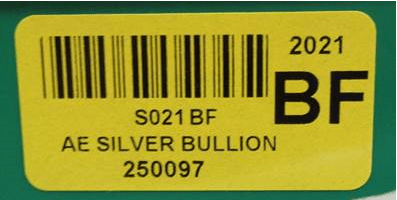
The U.S. Mint reports that some of the boxes marked with “BF” should not have the “F” since they were not part of the first production run.
Although the U.S. Mint has claimed it was always considerate to the collector community, it is the first time they voluntarily provided this information without prompting. Could the U.S. Mint finally be learning from past mistakes? Time will only tell.
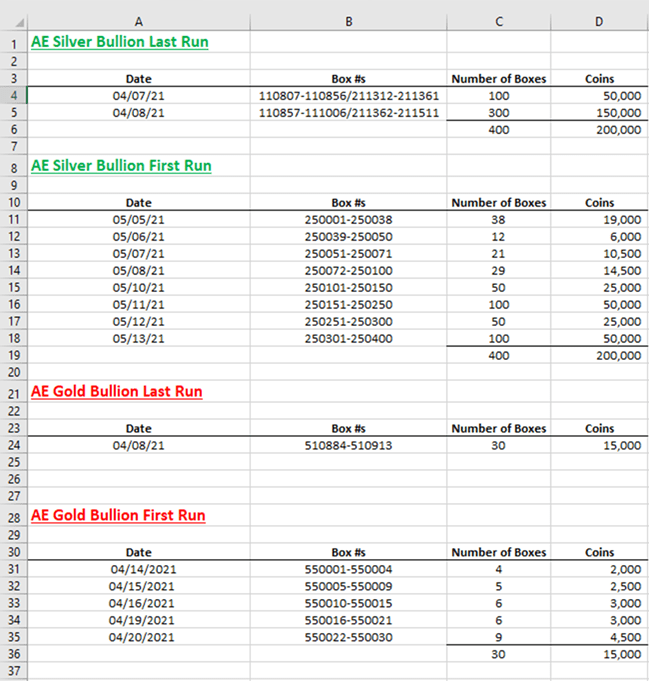
And now the news…

August 9, 2021
The 2,600-year-old site produced highly standardized “spade money,” possibly on government orders

→ Read more at
smithsonianmag.com

August 9, 2021
'Remarkable' collection of 52 Tudor, Stuart and Commonwealth coins is set to sell for £500,000 at auction — including a Henry VIII coin struck in tribute to his first wife Catherine of Aragon

→ Read more at
dailymail.co.uk

August 11, 2021
A scavenger hunt at a Talmud-era village in northern Israel took a surprising turn on Tuesday when an Israeli girl found a 1,500-year-old bronze coin.

→ Read more at
israelhayom.com

August 11, 2021
While out camping with family on the beach, Yotam Dahan discovers 13-pound lump of coins from about 1,700 years ago which archeologists speculate belonged to a merchant ship that wrecked ashore

→ Read more at
ynetnews.com

August 11, 2021
TEHRAN – Iranian authorities have seized some ancient coins from an illegal digger in the western province of Ilam, the provincial tourism chief announced on Wednesday.

→ Read more at
tehrantimes.com
If you like what you read, share and show your support 
Jul 23, 2021 | commentary, US Mint
In this final installment of my look at the U.S. Mint’s current problems, I will translate the expletives I wrote in the margins of my notes into an editorial about what I learned.
 The impression left by the U.S. Mint officials I spoke with is that the lawyers had more say over policy than the appointed director or the career executives. When questioned as to why the U.S. Mint did not implement additional cybersecurity measures against Internet robots, the answer was that the lawyers prevented a sound business decision.
The impression left by the U.S. Mint officials I spoke with is that the lawyers had more say over policy than the appointed director or the career executives. When questioned as to why the U.S. Mint did not implement additional cybersecurity measures against Internet robots, the answer was that the lawyers prevented a sound business decision.
I do not know why the lawyers prevented the U.S. Mint from implementing appropriate cybersecurity controls to prevent Internet robots and other abuses. Whatever the reason, it caused the U.S. Mint to violate the Federal Information Security Management Act (FISMA). Ignorance of FISMA put the U.S. Mint’s cybersecurity in jeopardy during a time when the Internet is becoming more dangerous.
When I used to work as an information security contractor for the U.S. government, including with Treasury bureaus, agencies would work in anticipation of the passage of relevant laws. When I worked for the IRS, another Treasury bureau, the lawyers and analysts would work on the implementation requirements for the new law. They drafted everything from new forms to planning for the programming necessary to implement the new law. Other agencies did the same. If the lawyers prevented the U.S. Mint from anticipating the passage of a law, then the lawyers are overanalyzing the law. It is called being pedantic.
Where was the U.S. Mint management? The lawyers are supposed to provide advice. They are not supposed to be the final answer. Even though the U.S. Mint did not have a permanent director until David Ryder was confirmed by the Senate, someone was in charge. Why is that person not held responsible for the problems?

David J. Ryder at the hearing regarding his nomination to be the 39th Director of the U.S. Mint
Has Ryder even worked on the security of U.S. coinage? Criminals are duping the collecting public by peddling counterfeit American Silver Eagles. Why has the U.S. Mint not implemented security features in the American Eagle program? If the security of the physical currency is Ryder’s specialty, why has he not implemented it to protect the public?
This is not Ryder’s first rodeo. He was appointed the U.S. Mint director in 1992 by President George H.W. Bush. Ryder should understand how the government works. But his performance during his current appointment and the decisions he has made have the numismatic public questioning his competence.
When someone writes a critical opinion piece, they should provide possible solutions. In this case, I am not sure that any suggestion would work. The U.S. Mint does not listen to the collecting public. When they feign interest, the people who try to be responsive move along with the political winds, and new appointees ignore the lessons of the past under the guise of “Not invented here.”
A common problem among political appointees is that they come into any job thinking they know better than career appointees. It causes them to ignore the past and rediscover previous mistakes. I spent a career fixing the security problems caused by mistakes made by appointees.
I wonder if a civilian advisory board would help the U.S. Mint? The board would consist of experts in numismatics and government processes. But it will give the bureau someone to blame if something goes wrong because if I learned nothing else from my 25 years working for the government, career executives and appointees are collectively risk-averse.
If you like what you read, share, and show your support 
Jul 22, 2021 | security, silver, US Mint
This is the second article of three regarding the recent problems at the U.S. Mint.

It is as if the U.S. Mint did not learn a lot since the fiasco of the 2014 Kennedy Half Dollar 50th Anniversary Gold Coin release. (Image courtesy of ABC 7 News, Denver)
Last month, a discussion was held with a representative of the U.S. Mint’s communications department and a manufacturing supervisor to understand better the 2021 Morgan Dollar ordering failures. When asked about lessons learned from previous sales, they admitted to working at the U.S. Mint for four years or less and could not talk about previous issues.
After asking about lessons learned from the past with responses ringing like “not on my watch,” it brought to mind the first Numismatic Forum in 2016, where the only blogger in attendance asked whether the discussions would survive changes of leadership and administrations. Rhett Jeppson was nominated to be Director of the U.S. Mint but was never confirmed. Although there were three more Numismatic Forums, it is apparent that none of the discussions survived leadership changes.
Part of the problem is with the government’s Senior Executive Service (SES) program. Members of the SES are government employees hired to senior management positions within the federal government. They undergo special training in government leadership and understand how to lead their sections through policy changes. SES employees are supposed to be non-partisan government workers. There are also limited reasons for the SES to stay with the agency to build collective knowledge.
There are three ways an SES employee can be appointed. A career appointment is a merit position staffed by a qualified executive. A noncareer appointment is a temporary appointment and is subject to several restrictions, including the number of temporary appointees the government can hire. Finally, a limited appointment is hired for an 18 month to a three-year term. Rhett Jeppson’s role that made him the acting Director was the result of a limited appointment.
SES members are also encouraged to change agencies every four years. Although there are exceptions, the SES program is designed not to allow executives to become too powerful within the agencies. Forcing them to move reduces the risk of potential abuse of power.
As SES members come and go, the U.S. Mint loses the institutional knowledge they earned over the years. Experience working with members of the SES program shows that the new appointees rarely refer to documentation left by their predecessors. Their egos also have them ignoring employees and contractors with the institutional knowledge.
The U.S. Mint has resources in the numismatic community that can help teach them about the past. Having an engaged numismatic community available to help the U.S. Mint makes the bureau unique among government agencies. If their egos prevent them from reaching out to the numismatic community, the SES members can perform a web search on any topic to read what the numismatic press wrote about any issue.
During the discussion, the U.S. Mint emphasized how they wanted to work with the numismatic community and do their best to make the products accessible. While they will talk with members of the numismatic media, the U.S. Mint will not reach out for the community’s help.
The numismatic community wants the U.S. Mint to be able to support our collecting habits. They have a unique opportunity to engage a community willing to help. If the U.S. Mint wants to demonstrate that they are, they should set up a program of numismatic advisors to help them understand what went wrong in the past and how to make it better for the future.
If you like what you read, share, and show your support 
Jul 21, 2021 | bullion, coins, silver, US Mint
This is the first article of three regarding the recent problems at the U.S. Mint.
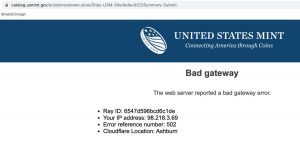 Economic analysts believe there is a silver shortage but that it is not critical. According to the supply chain reports, a sufficient supply of industrial silver for manufacturers to keep up with production. The reduction in computer chip production because of COVID-based plant shutdowns is the greatest threat to manufacturing.
Economic analysts believe there is a silver shortage but that it is not critical. According to the supply chain reports, a sufficient supply of industrial silver for manufacturers to keep up with production. The reduction in computer chip production because of COVID-based plant shutdowns is the greatest threat to manufacturing.
Jewelry and other businesses that use silver for their beauty are experiencing a slowdown but not to the extent of the computer chip industry. The industry has been able to use recycled silver fueled by people cashing in their scrap silver. One silver refiner reports that they have more work than they can process.
Although manufacturers have silver to maintain production, the U.S. Mint announced on May 28, 2021, that “The global silver shortage has driven demand for many of our bullion and numismatic products to record heights.”
On June 2, the U.S. Mint clarified their statement by saying, “In a message released Friday, May 28, we made reference to a global shortage of silver. In more precise terms, the silver shortage being experienced by the United States Mint pertains only to the supply of silver blanks among suppliers to the U.S. Mint.”
Why is the U.S. Mint different from the other industries?
The short answer is that the U.S. Mint is just another government agency subject to federal law.
The U.S. Mint is required to buy silver mined in the United States within one year of its mining (31 U.S. Code §5132(a)(2)(D)). Under this law, the U.S. Mint cannot use recycled silver or silver that the government has not purchased from the mines.
The U.S. Mint discontinued assay operations shortly after the passage of the Coinage Act of 1964. Since then, the bureau has bought the metals from other manufacturers, either sheets or already formed planchets. When the American Eagle Program started, the law required the U.S. Mint to use the silver in the Strategic and Critical Materials Stockpile. The U.S. Mint manufactured the planchets in West Point.
When the program depleted the Strategic Stockpile, Congress updated the law to require the U.S. Mint to use freshly mined silver. They found that it was more cost-effective to have a commercial vendor manufacture the planchets.
Hiring a commercial vendor to do work for the federal government is different from a business-to-business transaction. The government requires all contracts and contractors to follow the Federal Acquisition Regulations (FAR) to purchase goods and services.
For the government to contract with any company, a bidding and vetting process can last from weeks to years. The agency has to produce requirements, selection criteria and evaluate the proposals, called source selection.
Congress purposely made the process challenging to promote fairness in the bidding process and ensure the government pays a fair price. Unfortunately, the process is expensive and fraught with problems.
For the U.S. Mint, the problem is that FAR does not allow the latitude to find alternate vendors when there are supply issues.
The U.S. Mint has contracts with four vendors to make silver planchets. They have vetted the contractors, their processes and have contractual quality control measures to ensure the planchets comply with the Treasury’s legal and quality requirements. If the vendors cannot fulfill the U.S. Mint’s order, the law prevents them from looking for immediate alternatives.
According to the U.S. Mint, the suppliers of silver planchets had production slowdowns because of COVID-19 operating precautions. In addition to manufacturing issues, the mining operators also experienced slowdowns because of the same operating precautions. Every industry is experiencing supply chain interruptions.
Where the U.S. Mint could have done better was to order the planchets sooner. The U.S. Mint reported that agency attorneys refused to allow their purchasers to order planchets before the law was signed. The bill, H.R. 6192, was sent to the president on December 24, 2020. The president signed the bill into law on January 5, 2021 (Public Law No. 116-286).
When a law is signed, the White House will tell the appropriate Departments. If that does not happen, the agencies receive notice from the Government Printing Office (GPO) who publishes the laws. Like everything else, the GPO has experienced interruptions because of pandemic protocols.
According to a government attorney that works for the Inspector General’s office in a non-Treasury department, agencies have the latitude to work on anticipated laws. An example cited is that the IRS works on drafting forms and regulations based on the bills in progress to be ready for the filing season.
Although Congress did not do the U.S. Mint a favor by passing the bill on Christmas Eve, the White House did not do the U.S. Mint a favor by not letting the Treasury know they signed the bill. However, the leadership of the U.S. Mint allowed the lawyers to dictate operations. The lawyers are supposed to be advisors, not the last word.
If you like what you read, share, and show your support 
Jul 20, 2021 | coins, Eagles, US Mint
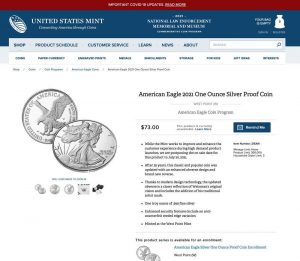 I was able to order the 2021-W American Silver Eagle one-ounce proof coin today with only minor issues.
I was able to order the 2021-W American Silver Eagle one-ounce proof coin today with only minor issues.
Like every other time I ordered new releases from the U.S. Mint, I logged into my account before the sale. I verified that the credit card I had registered was the correct card. The card was in front of me just in case something went wrong.
As the time closed in at noon, I tapped the refresh button. As soon as the button changed from “Remind Me” to “Add to Bag,” I began tapping.
When the page did not respond immediately, I panicked and tapped again. Of course, I should know better. But I am an anxious collector who cares what my background is. After tapping more than once, the coin appeared in my bag, and I pressed checkout.
I did not look at the contents of my bag as I scrolled down to my payment option. I selected my stored credit card then watched as it took too long to fill the form. As it took time, I was pressing buttons faster than the website responded. After the system finally filled in the form, I forgot to enter the CVV for my card. Then another tap.
Once the confirmation page appeared, I took a screenshot of the information for safekeeping. That is when I realized my nervous tapping added more than one coin to my bag. It looks like I ordered three coins. It also may explain an error I received during the tapping on the link when the system thought I was overfilling my bag.
As I type this, the coin sold out. I do not know how long it was before the coin sold out because I had to put down my iPad and go back to work. It looks like if you missed the opportunity to order, then you would have to purchase one on the secondary market.
A quick search on eBay suggests that the presale for graded coins is averaging $135-150.
Jul 18, 2021 | coins, news, US Mint
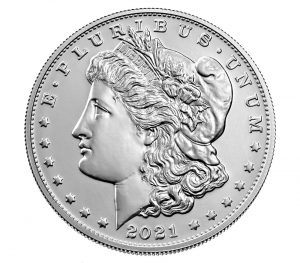 The U.S. Mint announced the new ordering procedures for upcoming silver products and that there will be changes to the bulk purchase system. Most collectors met both news items with a collective yawn.
The U.S. Mint announced the new ordering procedures for upcoming silver products and that there will be changes to the bulk purchase system. Most collectors met both news items with a collective yawn.
For many years the U.S. Mint has promised improvements for the collector and access to their products. During that time, the collecting public held their collective breaths hoping that they will get it right. After failing to show progress, collectors are not optimistic.
According to the U.S. Mint, the problems are a low supply of planchets and Internet robot ordering on a broken ordering system. The supply issue has acceptable reasons external to the Mint. The broken ordering system and managing against the bots is the direct responsibility of the U.S. Mint.
Even if they fix the ordering and distribution systems for the upcoming product, it will take a long time for the U.S. Mint to gain the trust of collectors.
And now the news…

July 13, 2021
The association says the suspension of the program has been a burden to scrap recyclers across the country. The Washington-based Institute of Scrap Recycling Industries (ISRI) is urging the U.S. government to reinstate its mutilated coin redemption program, which was suspended in 2019.

→ Read more at
recyclingtoday.com

July 14, 2021
When the first modern Olympics were held in Athens in 1896, winners did not get gold medals as they will later this month when the Tokyo games get underway. Instead, they got silver, while runners-up got bronze. There were no medals for third place.

→ Read more at
thenationalherald.com

July 14, 2021
A rainstorm in London has led to the discovery of a hoard of more than 300 coins dated to the first century B.C.

→ Read more at
smithsonianmag.com

July 15, 2021
A German federal court on Tuesday rejected the appeal of two defendants who had been jailed for stealing a massive gold coin from Berlin's Bode Museum. The court in the city of Leipzig concluded that there were no "legal errors to the disadvantage of the defendants" in their February 2020 sentencing and, as such, their prison terms were found to be legally binding.

→ Read more at
dw.com

July 15, 2021
A Viking era "piggybank" of silver coins has been discovered on the Isle of Man by a metal detectorist who made another startling discovery last year.

→ Read more at
bbc.com

July 16, 2021
THE Bangko Sentral ng Pilipinas (BSP) issued a new warning to the public about the supposed "Brilliant Uncirculated 20-Piso" coin being sold online.

→ Read more at
manilatimes.net
If you like what you read, share, and show your support 
Jul 2, 2021 | coins, US Mint, video
As more people come out of their pandemic bubble, some areas continue to report a coin shortage. Although it appears to be a shortage in circulating coinage, there is a reduction of coin available for merchants to give change. Although the situation has improved, the problem is that coins are still not circulating.
In a video by U.S. Mint Director David Ryder, he reports that the Mint has increased production during the last year. Typically, the U.S. Mint supplies less than 20-percent of the coin in circulation. Last year, the U.S. Mint increased production to add 30-percent of the coins in circulation.
Given the situation with the pandemic that caused the West Point Mint to shut down and pause Philadelphia, the fact that the U.S. Mint was able to produce more coins than ever is a significant accomplishment. Regardless of your opinion as to how the U.S. Mint has handled the sale of collector coins, no other mint in the world could accomplish this feat.
In 2020, the U.S. Mint struck 14.774 BILLION coins. But in 2019, a year where the economy was doing very well, the U.S. Mint produced 11.942 BILLION coins. They produced 23.7 more coins while taking precautions during a pandemic.
Nearly every industry reported a reduction in demand and the ability to produce products. And the supply chain continues to affect production in some industries, including tech, where there is a shortage of computer chips. But the U.S. Mint was able to add over 14 BILLION coins to the economy. Amazing!
May 30, 2021 | news, US Mint
 When it comes to identifying the numismatic-related news of the week, you cannot ignore the fiasco caused by the U.S. Mint. It is a repeat of every significant release for the last 15 years: underestimate demand, make purchasing policies that are out of touch with the demand anticipated by the industry, not have the infrastructure in place to meet the demand, apologize and promise to do better later.
When it comes to identifying the numismatic-related news of the week, you cannot ignore the fiasco caused by the U.S. Mint. It is a repeat of every significant release for the last 15 years: underestimate demand, make purchasing policies that are out of touch with the demand anticipated by the industry, not have the infrastructure in place to meet the demand, apologize and promise to do better later.
Wash, rinse, and repeat.
Collectors are not taking this situation in stride as they previously have. According to congressional staffers who spoke on the promise of anonymity, the calls to their offices bordered on outrage. The stories were amazing.
One staffer said that their district office received a call from an assisted living center in their district. Five people were on the call. Each made a statement and passed around the telephone, so they could all tell their members of congress how upset they were. One of the people told the staffer about buying his first proof set from the U.S. Mint in 1958.
Another staffer said that the House Financial Services Committee redirected calls made to their offices. Someone investigated and decided that something I wrote the day of the sale prompted the calls.
A source with the Treasury Department said that they logged a lot of calls on Wednesday. Although they would not break down the distribution of the calls, sources suggested that calls made to the main Treasury caught Secretary Janet Yellen’s attention.
Although members of the numismatic industry called, everyone I spoke with said it was the public’s outrage that caused the U.S. Mint to take quick action.
Instead of putting up with bad service from the government, the people stood up and asked for answers. The government responding to the people is the best news of the week. Now let’s hope the U.S. Mint does not waste this moment.
And now the news…

May 27, 2021
Cabinet policy addressing “colonialism, patriarchy, and racism” strikes coin honouring Canadian scientist who discovered insulin

→ Read more at
torontosun.com

May 28, 2021
During excavations near Tübingen, archaeologists discovered the tomb of an early Bronze Age woman with an unusual burial gift: a small spiral made of gold wire – possibly a hair ornament – appeared to be the earliest reliable gold discovery in southwestern Germany.

→ Read more at
thewestonforum.com

May 28, 2021
While working on the downtown Ellisville street repair project, Heath Pickering made an interesting find while repairing a sewer line.

→ Read more at
leader-call.com
If you like what you read, share, and show your support 
May 28, 2021 | dollar, nclt, news, US Mint
The U.S. Mint posted the following on its Facebook page at 11:30 PM on Thursday, May 27, 2021:
For those who do not access Facebook, the following is the complete text of the announcement:
The United States Mint is committed to providing the best possible online experience to its customers. The global silver shortage has driven demand for many of our bullion and numismatic products to record heights. This level of demand is felt most acutely by the Mint during the initial product release of numismatic items. Most recently in the pre-order window for 2021 Morgan Dollar with Carson City privy mark (21XC) and New Orleans privy mark (21XD), the extraordinary volume of web traffic caused significant numbers of Mint customers to experience website anomalies that resulted in their inability to complete transactions.
In the interest of properly rectifying the situation, the Mint is postponing the pre-order windows for the remaining 2021 Morgan and Peace silver dollars that were originally scheduled for June 1 (Morgan Dollars struck at Denver (21XG) and San Francisco (21XF)) and June 7 (Morgan Dollar struck at Philadelphia (21XE) and the Peace Dollar (21XH)). While inconvenient to many, this deliberate delay will give the Mint the time necessary to obtain web traffic management tools to enhance the user experience. As the demand for silver remains greater than the supply, the reality is such that not everyone will be able to purchase a coin. However, we are confident that during the postponement, we will be able to greatly improve on our ability to deliver the utmost positive U.S. Mint experience that our customers deserve. We will announce revised pre-order launch dates as soon as possible.
Sources reported that unhappy collectors “besieged” the U.S. Mint with email and telephone calls following their latest ordering fiasco. The sources also said that the offices of several members of congress contacted the U.S. Mint after hearing from their constituents.
One source said that collectors contacted the Treasury Office of Inspector General (OIG) and prompted them to question U.S. Mint management on the problems. I have not been able to confirm this story.
In short, it was the action by angry collectors that made the U.S. Mint stop and rethink its sales policies. It was you, the collector, who called Congress, made waves, and forced the U.S. Mint to listen.
Too bad ANA leadership did not take a leadership role on behalf of the hobby.
If you like what you read, share, and show your support 
 According to Coin World, the Treasury Office of Inspector General (OIG) “may” investigate how the U.S. Mint has handled the sales of limited-edition numismatic collectibles. Coin World may have confirmed information provided to me on background.
According to Coin World, the Treasury Office of Inspector General (OIG) “may” investigate how the U.S. Mint has handled the sales of limited-edition numismatic collectibles. Coin World may have confirmed information provided to me on background.

 → Read more at
→ Read more at 
 The impression left by the U.S. Mint officials I spoke with is that the lawyers had more say over policy than the appointed director or the career executives. When questioned as to why the U.S. Mint did not implement additional cybersecurity measures against Internet robots, the answer was that the lawyers prevented a sound business decision.
The impression left by the U.S. Mint officials I spoke with is that the lawyers had more say over policy than the appointed director or the career executives. When questioned as to why the U.S. Mint did not implement additional cybersecurity measures against Internet robots, the answer was that the lawyers prevented a sound business decision.





